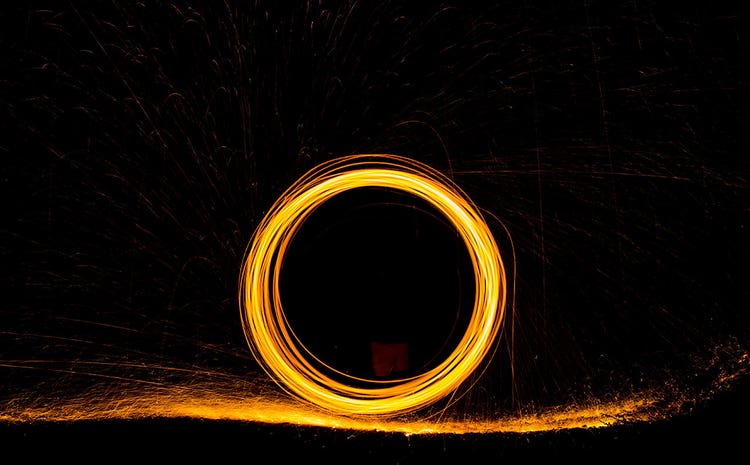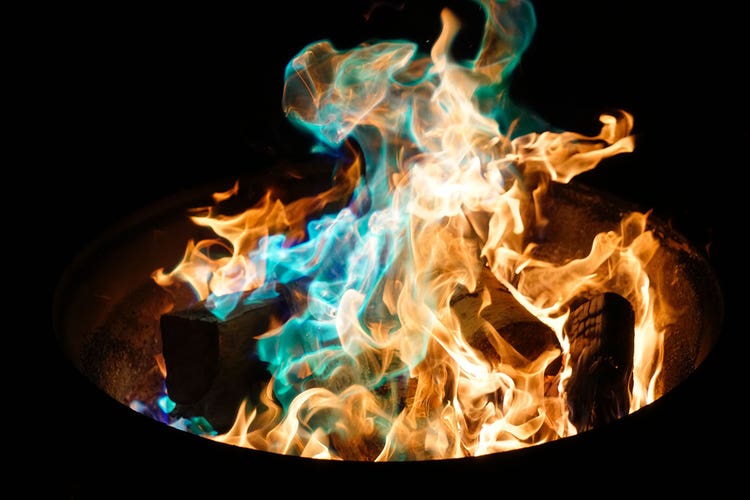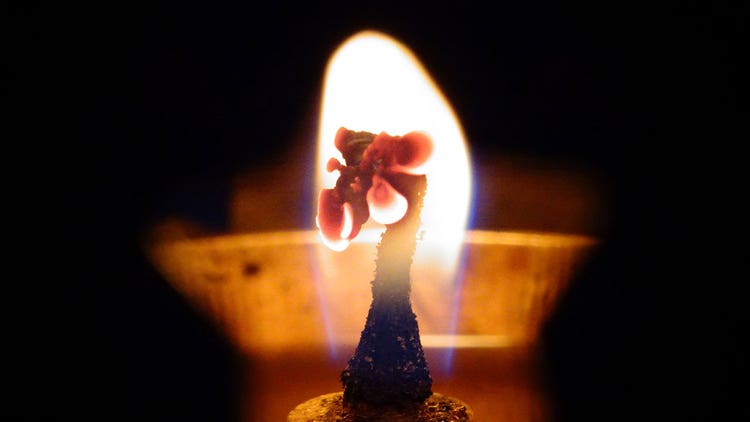Seven-Day Meditation

Use this ritual to let go of 2017.
The transition from one year to the next, the closing of a cycle, another three hundred and fifty-something days behind you, and here you are once again on the brink of a new year full of possibilities.
But alas, it’s still 2017; you aren’t in the new year just yet.
Rather than racing toward the future, making resolutions and plans for the year ahead, slow down this week and use this in-between time to reflect on the past year: what you’ve been through, how far you’ve come, when you were your happiest, how you’ve changed, what’s stayed the same, and what you perhaps wish you’d done differently. It’s a time to make amends with yourself, to wipe your slate clean, and to take inventory—clearing out old, unhelpful patterns and making room for new ways of being in 2018.
In other words, it’s the perfect time to let some stuff go. The heavy stuff. The grudges and grievances, anxieties and fears, people and relationships, old stories and beliefs, difficult emotions and memories, and so forth that are weighing you down, taking you away from your happiness and well-being.
Often, such things have become habitual, or you’ve become stuck in a rut without recognizing it, which is why it’s important to set aside the time to sit and get real with yourself, to start acknowledging the things you intuitively know you need to let go of to feel and be your best self.
The week or so leading up to (or following) the new year presents a window of opportunity to engage in the process of letting go through journaling, meditation and ritual in a meaningful and symbolic way with the intention of honoring and releasing the energetic hold some of these things have on you. This can help you feel a bit lighter as you begin a new year.
Mantra meditation: trust and let go

The following meditation is designed to connect you to the felt-sense experience of letting go, releasing physical, mental and emotional tension in the body as you breathe. Easy yet profound, this simple mantra meditation has a way of quickly shifting your energy (especially the more often you practice) and is a great tool for releasing stress.
In the days leading up to the new year, set aside three to five minutes a day to sit quietly and meditate on letting go.
- Feel free to sit comfortably, whether that’s on a blanket or cushion on the floor or upright in a chair.
- When you’re ready, gently close your eyes and take a few deeper breaths, sighing on your exhales. Settling into your seat, release the backs of your legs into the floor or chair, gently lengthen up through the crown of your head, and soften into the space behind you.
- Deepen your breath, expanding through the low lungs, ribs and chest as you inhale fully and then softening your skin and the muscles of your face, jaw and neck as you slowly exhale. On your inhales, quietly say to yourself “trust.” On your exhales, quietly repeat “let go.” Inhaling “trust,” exhaling “let go.”
When you’re through (and I highly suggest using a timer if you’re newer to the practice), drop the mantra and spend a few moments observing the way you feel. Afterward, you may want to write down anything that came up during meditation or reflect on any differences—any subtle physical, emotional, mental or energetic shifts—you notice.
Fire ceremony for letting go

Considered sacred across spiritual traditions, fire is the agent of destruction, creation and purification—the element of transformation.
In shamanic traditions, the fire ceremony is a powerful practice used to release unwanted energies, old stories, limiting belief structures, negative emotions, disturbing memories, fears or anything that’s not serving your highest self so healing and transformation can take place. Fire has the power to transform, transmuting anything you place into it and sending it into the ethers—handing it over to spirit.
The ritual is a way of not only letting go but also honoring the lessons you’ve received while offering prayer and gratitude. Generally held around the time of new and full moons each month—as well as on other auspicious days—when the veils between worlds are considered thinnest, fire ceremonies also make space for new intentions and manifestations (perfect for the new year).
In the ancient tradition of yoga, fire rituals (known as “yajnas”) have been performed since the Vedic period and are commonplace in Hindu culture. Yajna refers to any ritual during which offerings are made into the sacred fire while mantras are being chanted. Oblations, such as rice, ghee, grains, cake and milk, are tossed into the sacred fire to please the gods. The Vedic fire god, Agni, is considered to be the messenger between worlds, delivering gifts to the gods in return for their good favor.
At the end of each mantra, “svaha” is uttered as the offerings are tossed into the sacred fire. The Sanskrit term literally means “well said;” however, I prefer the Tibetan translation “so be it,” especially when it comes to letting go of what is no longer serving you, as in, “I’ve made my offering, so be it—it’s out of my hands.”
Create your own New Year’s Eve fire ritual

Over the years, I’ve created my own fire ritual, picking up elements from different healers and medicine workers here and there and using what resonates with me. I love the practice of releasing whatever I need to let go of into the fire, transmuting the energy of it, while also thinking of it as an offering (svaha!). And it’s particularly magical at times of transition, like new/full moons, winter/summer solstice, birthdays, and of course, New Year’s Eve.
All you need to create your own fire ceremony for letting go is a candle, a safe place to burn something outdoors, and a pen and piece of paper. You may also want to build a makeshift altar, placing photos, crystals, incense, flowers and any personal items that carry meaning to you around your candle. More than anything, the intention that you are creating a ritual—something sacred out of the ordinary to honor the act of letting go—will be what infuses your fire ceremony with power and meaning.
- Begin by lighting your candle. Then softly close your eyes, deepen your breath and settle into your seat as you have been all week.
- Take a few moments to become grounded and centered, turning your awareness inward.
- Once you feel ready, lightly open your eyes and write this across the top of your paper: “I consciously choose to let go of …”
- Start listing anything and everything that comes up. Big, small, seemingly insignificant or wildly profound—it doesn’t matter. Let it all flow out onto the paper. (Once you get started, you’ll be surprised by how much comes to mind.) It can be old habits, patterns, and ways of thinking and being; specific relationships or a person’s hold on you; fears and perceived limitations; bodily aches and health issues; suffering of any variety; or the ideas, attitudes and belief structures imposed upon you by the media and our social conditioning that keep you playing small.
- When you feel finished (whether you’ve written down 30 things or just a few), write this at the bottom of the page: “With gratitude, love and compassion for myself and all those involved, I let go. I let go. I let go. Svaha!”
- Lightly crumple up the piece of paper, and head outside with it and your candle. Make sure you have a safe place to drop your burning paper into, preferably a fire pit, but an empty flowerpot will suffice.
- Before lighting the paper on fire with the flame of your candle, turn your face toward the moon and say out loud, “Dear Spirit, thank you for all the lessons and experiences you’ve imparted, but now I release what is no longer serving my highest self.”
- Hold your list to the flame, drop it into the pit (or pot) and watch the flames fully engulf the paper as the smoke carries your offering away. As the paper burns, chant, “Svaha! Svaha! Svaha!” Let it all go. Offer it up, and hand it all over to spirit. Svaha! So be it.
Afterward, spend some time just observing the way you feel, particularly noticing the energy or any sensations moving in your body. Then bring your hands together before your heart, filling up with gratitude, to close your ceremony.
You can repeat the ritual on, or within three days of, the first of the year, but this time with the intention of creating newness in your life, calling everything you’d like to happen into existence. This time, write “I consciously choose to create …” at the top of the page, and begin listing all your dreams, aspirations and whatever else you want for yourself in the new year.
Photo credit: AndrisBarbans, Thinkstock; chris rhoads, Unsplash; jeremy perkins, Unsplash; Vinay Panchal, Thinkstock